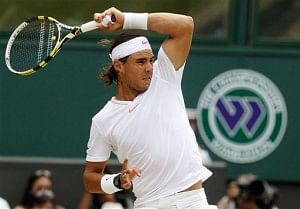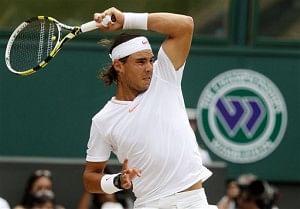
Wimbledon 2010: Nadal Erases The Doubts
If Tomas Berdych entered his match against Rafael Nadal in yesterday’s Wimbledon final showdown desperately hoping to avoid a thumping demolition, it didn’t show in his tennis, at least not early on in the match. Berdych’s serve seemed to have just as much ammunition as it did throughout his breakthrough fortnight, and his mammoth forehand and effortlessly powerful backhand were finding the corners with a minimum of fuss. He seemed to be getting deeper into Nadal’s service games than Nadal was getting into Berdych’s. The ‘big hitter’ syndrome seemed about to rear its head, with the familiar refrain that Nadal has trouble dealing with players who can belt the leather out of the ball starting to do the rounds. And then suddenly, with the score reading 3-3 in the first set, Nadal conjured up three break points, and Berdych seemed just as perplexed about how that had happened as the rest of us millions watching on TV. On the second of those breakpoints Nadal fired a bullet backhand return of serve that would have made any ‘big hitter’ proud. The serve had been conquered, the initiative had been grabbed and in the blink of an eye Berdych was looking down the barrel of a 3-5 hole and the specter of an early, momentum-quenching first set loss, which was duly hastened when he lost his serve for the second consecutive time. How accurate is it to keep calling Nadal a ‘grinder’? His sneaky, sudden strikes towards the late stages of sets all through this tournament have been positively Sampras-like. Maybe, just maybe, the knee injury that last year threatened to shorten his career if he didn’t respond to it by a change in his schedule or playing style, has turned into a blessing in disguise. How could it not, when it has seemingly turned him into an efficient (bet you never heard THAT word in connection with Nadal’s game before) winning machine?

2008 was Nadal’s pinnacle, the moment when he announced to the world that he was truly in contention to be talked about amongst the game’s greatest. This year, his victory was a reinforcement of everything that we already knew, but just doubted that wee bit because of his problems last year. Nadal is a great grasscourt player, not just a good one. Anyone who can play THAT match against the prohibitive Greatest Player of All Time and come out of it a winner is, has to be, a player worth mentioning in the history books for his grasscourt prowess alone.
Yes, we knew that, but we still had our doubts.
Nadal is perhaps the most determined player to have ever picked up a racquet. His refusal to give up or lessen his intensity by the slightest bit even in the face of the most trying circumstances imaginable has already reached legendary levels.
Yes, that was common knowledge to us, but we still suspected that this year was not going to be his year.
Nadal has improved his serve beyond recognition, to the point that it is now justifiably viewed as a formidable weapon, at least on grass. He may not hit a lot of aces, but the sheer smartness, variety and accuracy of his delivery works even better than a massive thunderbolt that is a supposed prerequisite of a true grasscourt master.
Yes, we knew this too, but did we believe that his artificially built serve would hold up for the full duration of the Wimbledon fortnight?
Nadal’s forehand is truly a fearsome force of nature – the power, offense, defense and consistency that he can squeeze out of it, sometimes all at once, should probably make it rank right up there with the forehand of a Graf or a Federer as one of the most lethal shots ever witnessed on a tennis court. Nadal’s movement remains just explosive as ever, and his transition from defense to offense, capped off by his incredibly effective volleys, seems to come straight out of a coaching manual.
Yes, we were fully aware of all of this, but we still tried to point out to his loss to Feliciano Lopez at Queen’s, the traditional grasscourt warm-up tournament, as reason to second guess his chances here.
Trust Nadal to ignore all of the naysayers, all the doubts, all the suspicions and simply turn around and do what he does best – win tennis matches. To do what Nadal does so effortlessly – to be able to concentrate fully at the job on hand no matter how many distractions and negative influences may surround him, and to do it over and over again (remember the 2009 Australian Open, anyone?), is not something that can be taught, of course. It can only be learned.
At the age of 24, Nadal has 8 Grand Slam titles – 5 at the French, 2 at Wimbledon and one in Australia. If it was too early to start mentioning his name among the top 10 tennis players of all time after he won his fourth consecutive Roland Garros title in 2008, it certainly isn’t so any more. What many analysts feared was an irreversible trend when Nadal failed to win a title for 11 months starting from Rome of last year has turned out to be just a minor blip, a temporary stumble that can be brushed aside when viewing Nadal’s career as a whole. He’s decisively proven that he’s the best player in the world on clay AND grass, and in what can only be seen as cause for alarm for the rest of the ATP, he’s already set his sights on winning the one piece missing from his resume – a US Open title.
Nadal has managed his schedule this year better than he has in years past, and he will likely go into the last Major of the year relatively fresh and eager to set the record straight. But most importantly of all, he’s visibly, almost dramatically, changed his style of play to make room for his ambitions to do well on faster courts. He almost never retreats behind the baseline in a neutral rally any more, and it’s he who’s the one making the sharp angles and putting on sudden bursts of energy in his strokes now. He conserves his energy when he needs to, and knows exactly when his opponent is likely to be most vulnerable to an unexpected guerilla attack. His last two matches at Wimbledon, first against Murray (where he broke Murray’s serve in the 9th and 10th games of the 1st and 3rd sets respectively) and then against Berdych (where the unfortunate Berdych lost his serve in the 12th and 10th games of the 2nd and 3rd sets respectively) were, as I said earlier, vividly reminiscent of the halcyon days of Pete Sampras, who knew better than anyone else how to make best use of his opportunities. But Sampras had the best serve in history to help him with that strategy. What does Nadal have? Only one of the best forehands in history, the most intimidating court coverage in history and without a doubt, the greatest mental strength in history. I’d say the kid is quite capable of doing well for himself.